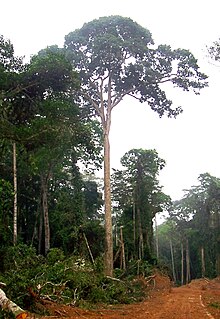Sapele: Difference between revisions
Rearranged article and added reference |
mNo edit summary |
||
| Line 22: | Line 22: | ||
==Description== |
==Description== |
||
''Entandrophragma cylindricum'' is native to tropical [[Africa]].<ref>http://www.worldagroforestry.org/usefultrees/pdflib/Entandrophragma_cylindricum_UGA.pdf |
''Entandrophragma cylindricum'' is native to tropical [[Africa]].<ref>[http://www.worldagroforestry.org/usefultrees/pdflib/Entandrophragma_cylindricum_UGA.pdf Entandrophragma cylindricum - World Forestry]</ref> There are protected populations and felling restrictions in place in various countries. |
||
The species grows to a height of up to 45 m (rarely 60 m). The [[leaf|leaves]] are [[deciduous]] in the [[dry season]], alternately arranged, pinnate, with 5-9 pairs of leaflets, each leaflet about 10 cm long. The [[flower]]s are produced in loose [[inflorescence]]s when the tree is leafless, each flower about 5 mm diameter, with five yellowish petals. The [[fruit]] is a pendulous [[capsule (fruit)|capsule]] about 10 cm long and 4 cm broad; when mature it splits into five sections to release the 15-20 [[seed]]s.<ref>[https://www.wood-database.com/wood-articles/sapele/ Sapele - The Wood Database]</ref> |
The species grows to a height of up to 45 m (rarely 60 m). The [[leaf|leaves]] are [[deciduous]] in the [[dry season]], alternately arranged, pinnate, with 5-9 pairs of leaflets, each leaflet about 10 cm long. The [[flower]]s are produced in loose [[inflorescence]]s when the tree is leafless, each flower about 5 mm diameter, with five yellowish petals. The [[fruit]] is a pendulous [[capsule (fruit)|capsule]] about 10 cm long and 4 cm broad; when mature it splits into five sections to release the 15-20 [[seed]]s.<ref>[https://www.wood-database.com/wood-articles/sapele/ Sapele - The Wood Database]</ref> |
||
Revision as of 13:50, 10 August 2018
| Sapele Entandrophragma cylindricum | |
|---|---|

| |
| A sapele tree in Brazzaville, Republic of the Congo | |
| Scientific classification | |
| Kingdom: | |
| (unranked): | |
| (unranked): | |
| (unranked): | |
| Order: | |
| Family: | |
| Genus: | |
| Species: | E. cylindricum
|
| Binomial name | |
| Entandrophragma cylindricum | |
Entandrophragma cylindricum is a tree of the genus Entandrophragma of the family Meliaceae. It is commonly known as sapele or sapelli (/səˈpiːliː/ sə-PEE-lee), as well as aboudikro, assi and muyovu.
Description
Entandrophragma cylindricum is native to tropical Africa.[2] There are protected populations and felling restrictions in place in various countries.
The species grows to a height of up to 45 m (rarely 60 m). The leaves are deciduous in the dry season, alternately arranged, pinnate, with 5-9 pairs of leaflets, each leaflet about 10 cm long. The flowers are produced in loose inflorescences when the tree is leafless, each flower about 5 mm diameter, with five yellowish petals. The fruit is a pendulous capsule about 10 cm long and 4 cm broad; when mature it splits into five sections to release the 15-20 seeds.[3]

Uses
The commercially important hardwood is reminiscent of mahogany, and is a part of the same Meliaceae family. It is darker in tone and has a distinctive figure, typically applied where figure is important. It has a density of 640 kg/m3. Demand for sapele increased as a mahogany substitute in recent years due to genuine mahogany becoming a CITES Appendix II listed species.[4] It is used in the manufacture of furniture, joinery, veneer and boat building.
Among its more exotic uses is that in musical instruments. It is used for the back and sides of acoustic guitar bodies, as well as the bodies of electric guitars. It is also used in manufacturing the neck piece of ukuleles and 26- and 36-string harps. In the late 90s, it started to be used as a board for Basque percussion instruments txalaparta.
References
- ^ Hawthorne, W. (1998). Entandrophragma cylindricum. The IUCN Red List of Threatened Species 1998: e.T33051A9753619. https://dx.doi.org/10.2305/IUCN.UK.1998.RLTS.T33051A9753619.en. Downloaded on 21 July 2018.
- ^ Entandrophragma cylindricum - World Forestry
- ^ Sapele - The Wood Database
- ^ Mahogany Mixups: the Lowdown - The Wood Database
External links
 Media related to Entandrophragma cylindricum at Wikimedia Commons
Media related to Entandrophragma cylindricum at Wikimedia Commons

